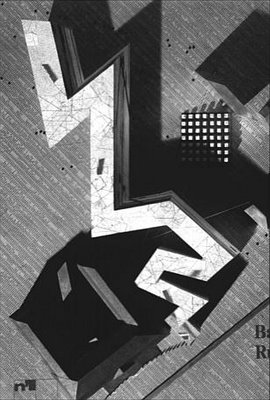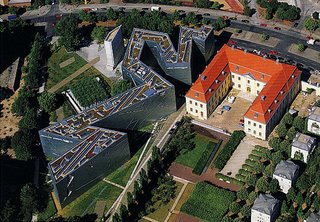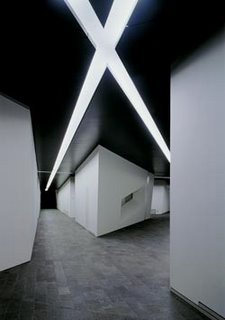
 This building, one that I unfortunately have yet to see in person, is without a doubt my most favourite piece of architecture. It demonstrates how brief, understanding of form, and individual brilliance in conception can be brought together in creating a 'speaking' architecture. This 'petrified flash of lightning' answers a lot of questions about what architecture's function in society should be, what it should speak of, and in what manner it should speak.
This building, one that I unfortunately have yet to see in person, is without a doubt my most favourite piece of architecture. It demonstrates how brief, understanding of form, and individual brilliance in conception can be brought together in creating a 'speaking' architecture. This 'petrified flash of lightning' answers a lot of questions about what architecture's function in society should be, what it should speak of, and in what manner it should speak. Libeskind won a hotly contested international competition on the back of a rather esoteric and ephemeral entry, which he entitled 'Between The Lines'. The drawings for this entry are beautiful and engaging entities in themselves, and Libeskind created an evocative intertwining of text and image to outline the story he wanted to tell.
Libeskind won a hotly contested international competition on the back of a rather esoteric and ephemeral entry, which he entitled 'Between The Lines'. The drawings for this entry are beautiful and engaging entities in themselves, and Libeskind created an evocative intertwining of text and image to outline the story he wanted to tell. The original brief was the replacement of the original Jewish Museum in Berlin, which opened with catastrophic timing in 1933, one week before the installation of Hitler as Chancellor, was badly damaged and thoroughly looted on Kristallnacht in 1938 and ultimately totally dismantled. The organisers of the competition set out an edgy and difficult triad of considerations for the proposals. They were to focus on:
The original brief was the replacement of the original Jewish Museum in Berlin, which opened with catastrophic timing in 1933, one week before the installation of Hitler as Chancellor, was badly damaged and thoroughly looted on Kristallnacht in 1938 and ultimately totally dismantled. The organisers of the competition set out an edgy and difficult triad of considerations for the proposals. They were to focus on:(1) the Jewish religion, customs, and ritual objects; (2) the history of the Jewish community in Germany, its rise and terrible destruction at the hands of the Nazis; and (3) the lives and works of Jews who left their mark on the face and the history of Berlin over the centuries. Even given the ultimately integrationist aims of the competition, avoiding a grim memorial relic of a building would be the greatest challenge.
Libeskind's scheme, 'Between The Lines', aimed to create:

'...two lines of thinking, organization, and relationship. One is a straight line, but broken into many fragments; the other is a tortuous line, but continuing indefinitely. These two lines develop architecturally and programmatically through a limited but definite dialogue. They also fall apart, become disengaged, and are seen as separated. In this way, they expose a void that runs through this museum and through architecture, a discontinuous void.'Libeskind, through form and programme,
 recreates the history of the Jewish people in Germany. The straight line, broken into fragments can be conceived as the Jewish presence in Berlin and Germany, punctuated by voids, absences, and silence. The tortuous yet continuing line is the shared destiny of the city. These are simplistic interpretations of what is a complex and multi-layered design, but what one can feel simply through looking at pictures of the evocative interiors and exterior is the powerful juxtaposition of solid and void, presence and absence. Visitors, in traversing the museum in order to move through the various exhibition areas, must go over sixty bridges through the void spaces which cut through the building's volume.
recreates the history of the Jewish people in Germany. The straight line, broken into fragments can be conceived as the Jewish presence in Berlin and Germany, punctuated by voids, absences, and silence. The tortuous yet continuing line is the shared destiny of the city. These are simplistic interpretations of what is a complex and multi-layered design, but what one can feel simply through looking at pictures of the evocative interiors and exterior is the powerful juxtaposition of solid and void, presence and absence. Visitors, in traversing the museum in order to move through the various exhibition areas, must go over sixty bridges through the void spaces which cut through the building's volume.
 The exterior has been 'written upon' - appearing almost scarred, imprinted with arcane patterns and displaced fragments. Exterior space has been considered as an integral feature of the building, with the 'Garden of Exile' - 49 six-metre high columns through which visitors can wander, and the immensely evocative (although somewhat 'folly'-ish) 'Holocaust Tower' - a bare concrete tower, the interior of which is neither heated or cooled, with a single unreachable aperture opening to the outside. Friends (both architects and non-architects) who have been in this space all attest to the immense power of the simple gesture made by this space.
The exterior has been 'written upon' - appearing almost scarred, imprinted with arcane patterns and displaced fragments. Exterior space has been considered as an integral feature of the building, with the 'Garden of Exile' - 49 six-metre high columns through which visitors can wander, and the immensely evocative (although somewhat 'folly'-ish) 'Holocaust Tower' - a bare concrete tower, the interior of which is neither heated or cooled, with a single unreachable aperture opening to the outside. Friends (both architects and non-architects) who have been in this space all attest to the immense power of the simple gesture made by this space. To return to the original point I made, that this building demonstrates architecture's power to speak, think about what Libeskind has done. By taking themes of absence and presence, and working these into the design in a concrete, tangible way, the architecture moves beyond something which must be explained - a piece of art that you have to read a pamphlet before you can sagely nod, grasping your chin - and into the realm of 'speaking' architecture: one forms one's own opinion, but is forcefully guided by powerful, masterful narrative.
To return to the original point I made, that this building demonstrates architecture's power to speak, think about what Libeskind has done. By taking themes of absence and presence, and working these into the design in a concrete, tangible way, the architecture moves beyond something which must be explained - a piece of art that you have to read a pamphlet before you can sagely nod, grasping your chin - and into the realm of 'speaking' architecture: one forms one's own opinion, but is forcefully guided by powerful, masterful narrative. Perhaps most brilliantly, the building constitutes an 'emblem of hope'. Libeskind has allowed both lines of the programme - the 'tortuous continuous' line and the 'straight, fragmented' line to coexist, such that our interpretation springs from the synthesis of the two, suggesting that rather than a solution or a closed book, the design logic presents a way forward. In his own words:
Perhaps most brilliantly, the building constitutes an 'emblem of hope'. Libeskind has allowed both lines of the programme - the 'tortuous continuous' line and the 'straight, fragmented' line to coexist, such that our interpretation springs from the synthesis of the two, suggesting that rather than a solution or a closed book, the design logic presents a way forward. In his own words:The work is conceived as a museum for all Berliners, for all citizens. Not only those of the present, but those of the future who might find their heritage and hope in this particular place. With its special emphasis on the Jewish dimension of Berlin's history, this building gives voice to a common fate - to the contradictions of the ordered and disordered, the chosen and not chosen, the vocal and silent. I believe that this project joins Architecture to questions that are now relevant to all humanity. To this end, I have sought to create a new Architecture for a time which would reflect an understanding of history, a new understanding of Museums and a new realization of the relationship between program and architectural space. Therefore this Museum is not only a response to a particular program, but an emblem of Hope.
* * * * *
So that's the last and "most favourite" of all Den's buildings. Look for a wrap-up from him on our series some time next week -- and go right ahead and comment yourself right here, right now. Remember those two questions I suggested on which to base your comments: First, is this good architecture? And second, do you like it. And remember to say why!RELATED: Architecture
No comments:
Post a Comment